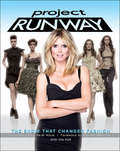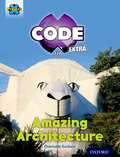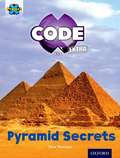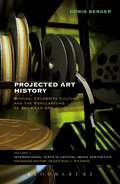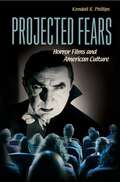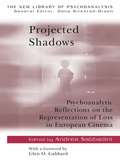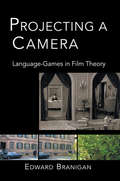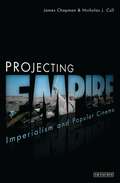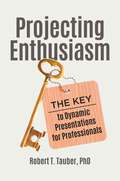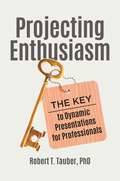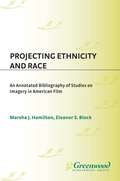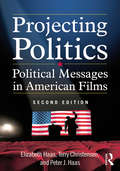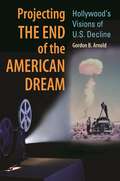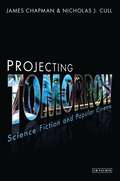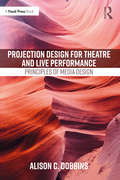- Table View
- List View
Project Planning, and Control
by David G. CarmichaelProject management is widely used in the construction industry and is central to planning and controlling time, costs and resources. This book enables readers to perform more effectively, to understand project planning and control procedures and to gain an insight into the associated skills. Numerous case examples from diverse industries and exercises support and illustrate important concepts. The result is a new perspective for project managers: planning can be shown to be a systems synthesis or an inverse problem, which provides a way to reach a satisfactory solution, avoiding the time-consuming or impractical search for the optimal solution.
Project Planning, and Control
by David G. CarmichaelProject management is widely used in the construction industry and is central to planning and controlling time, costs and resources. This book enables readers to perform more effectively, to understand project planning and control procedures and to gain an insight into the associated skills. Numerous case examples from diverse industries and exercises support and illustrate important concepts. The result is a new perspective for project managers: planning can be shown to be a systems synthesis or an inverse problem, which provides a way to reach a satisfactory solution, avoiding the time-consuming or impractical search for the optimal solution.
Project Runway: The Show That Changed Fashion
by Eila MellProject Runway, the groundbreaking reality television series, premiered in 2004. Ten seasons into its run comes the official guide behind the scenes of a television and fashion landmark. In this book, fully illustrated with hundreds of photos, fans will learn how the show began and developed over the years, relive the highlights of seasons past, and learn what their favorite designers are doing today. The book will feature commentary from Heidi Klum throughout, as well as interviews with the people behind the scenes, top designers of ten seasons, and stars of the show: workroom mentor Tim Gunn and judges Heidi Klum, Nina Garcia, and Michael Kors. This is the ultimate source for all things Project Runway.
Project Succulent: Genius Ideas for Arranging Succulents, Cacti & Air Plants (Living with Plants)
by Baylor ChapmanEasy, affordable, and oh-so-sweet, succulents take the center stage here in 25 stylish plant projects, accompanied by helpful information on caring for these rugged showstoppers.
Project X CODE Extra: Gold Book Band, Oxford Level 9: Marvel Towers: Amazing Architecture
by Charlotte GuillainProject X CODE Extra introduces more exciting adventure stories and stimulating non-fiction texts into the Project X CODE series, to provide additional practice outside of the core intervention sessions. Find out what inspired the world's most strange and stunning structures in this fascinating non-fiction book in the Marvel Towers zone.
Project X CODE Extra: Purple Book Band, Oxford Level 8: Pyramid Peril: Pyramid Secrets (Project X Code Ser.)
by Jane PenroseProject X CODE Extra introduces more exciting adventure stories and stimulating non-fiction texts into the Project X CODE series, to provide additional practice outside of the core intervention sessions. How did the Egyptians stack 2 million stone blocks to make the Great Pyramid? Find out in this fact-filled Pyramid Peril non-fiction book.
Projected Art History: Biopics, Celebrity Culture, and the Popularizing of American Art (International Texts in Critical Media Aesthetics)
by Doris BergerBiopics on artists influence the popular perception of artists' lives and work. Projected Art History highlights the narrative structure and images created in the film genre of biopics, in which an artist's life is being dramatized and embodied by an actor. Concentrating on the two case studies, Basquiat (1996) and Pollock (2000), the book also discusses larger issues at play, such as how postwar American art history is being mediated for mass consumption. This book bridges a gap between art history, film studies and popular culture by investigating how the film genre of biopics adapts written biographies. It identifies the functionality of the biopic genre and explores its implication for a popular art history that is projected on the big screen for a mass audience.
Projected Art History: Biopics, Celebrity Culture, and the Popularizing of American Art (International Texts in Critical Media Aesthetics)
by Doris BergerBiopics on artists influence the popular perception of artists' lives and work. Projected Art History highlights the narrative structure and images created in the film genre of biopics, in which an artist's life is being dramatized and embodied by an actor. Concentrating on the two case studies, Basquiat (1996) and Pollock (2000), the book also discusses larger issues at play, such as how postwar American art history is being mediated for mass consumption. This book bridges a gap between art history, film studies and popular culture by investigating how the film genre of biopics adapts written biographies. It identifies the functionality of the biopic genre and explores its implication for a popular art history that is projected on the big screen for a mass audience.
Projected Fears: Horror Films and American Culture
by Kendall R. PhillipsMovie audiences seem drawn, almost compelled, toward tales of the horrific and the repulsive. Partly because horror continues to evolve radically—every time the genre is deemed dead, it seems to come up with another twist—it has been one of the most often-dissected genres. Here, author Kendall Phillips selects ten of the most popular and influential horror films—including Dracula, Night of the Living Dead, Halloween, The Silence of the Lambs, and Scream, each of which has become a film landmark and spawned countless imitators, and all having implications that transcend their cinematic influence and achievement. By tracing the production history, contemporary audience response, and lasting cultural influence of each picture, Phillips offers a unique new approach to thinking about the popular attraction to horror films, and the ways in which they reflect both cultural and individual fears. Though stylistically and thematically very different, all of these movies have scared millions of eager moviegoers. This book tries to figure out why.
Projected Shadows: Psychoanalytic Reflections on the Representation of Loss in European Cinema (The New Library of Psychoanalysis)
by Andrea SabbadiniProjected Shadows presents a new collection of essays exploring films from a psychoanalytic perspective, focusing specifically on the representation of loss in European cinema. This theme is discussed in its many aspects, including: loss of hope and innocence, of youth, of consciousness, of freedom and loss through death. Many other themes familiar to psychoanalytic discourse are explored in the process, such as: Establishment and resolution of Oedipal conflicts Representation of pathological characters on the screen Use of unconscious defence mechanisms The interplay of dreams, reality and fantasy Projected Shadows aims to deepen the ongoing constructive dialogue between psychoanalysis and film. Andrea Sabbadini has assembled a remarkable number of internationally renowned contributors, both academic film scholars and psychoanalysts from a variety of cultural backgrounds, who use an array of contemporary methodologies to apply psychoanalytic thinking to film. This original collection will appeal to anyone passionate about film, as well as professionals, academics and students interested in the relationship between psychoanalysis and the arts.
Projected Shadows: Psychoanalytic Reflections on the Representation of Loss in European Cinema (The New Library of Psychoanalysis)
by Andrea SabbadiniProjected Shadows presents a new collection of essays exploring films from a psychoanalytic perspective, focusing specifically on the representation of loss in European cinema. This theme is discussed in its many aspects, including: loss of hope and innocence, of youth, of consciousness, of freedom and loss through death. Many other themes familiar to psychoanalytic discourse are explored in the process, such as: Establishment and resolution of Oedipal conflicts Representation of pathological characters on the screen Use of unconscious defence mechanisms The interplay of dreams, reality and fantasy Projected Shadows aims to deepen the ongoing constructive dialogue between psychoanalysis and film. Andrea Sabbadini has assembled a remarkable number of internationally renowned contributors, both academic film scholars and psychoanalysts from a variety of cultural backgrounds, who use an array of contemporary methodologies to apply psychoanalytic thinking to film. This original collection will appeal to anyone passionate about film, as well as professionals, academics and students interested in the relationship between psychoanalysis and the arts.
Projecting a Camera: Language-Games in Film Theory
by Edward BraniganIn Projecting a Camera, film theorist Edward Branigan offers a groundbreaking approach to understanding film theory. Why, for example, does a camera move? What does a camera "know"? (And when does it know it?) What is the camera's relation to the subject during long static shots? What happens when the screen is blank? Through a wide-ranging engagement with Wittgenstein and theorists of film, he offers one of the most fully developed understandings of the ways in which the camera operates in film. With its thorough grounding in the philosophy of spectatorship and narrative, Projecting a Camera takes the study of film to a new level. With the care and precision that he brought to Narrative Comprehension and Film, Edward Branigan maps the ways in which we must understand the role of the camera, the meaning of the frame, the role of the spectator, and other key components of film-viewing. By analyzing how we think, discuss, and marvel about the films we see, Projecting a Camera, offers insights rich in implications for our understanding of film and film studies.
Projecting a Camera: Language-Games in Film Theory
by Edward BraniganIn Projecting a Camera, film theorist Edward Branigan offers a groundbreaking approach to understanding film theory. Why, for example, does a camera move? What does a camera "know"? (And when does it know it?) What is the camera's relation to the subject during long static shots? What happens when the screen is blank? Through a wide-ranging engagement with Wittgenstein and theorists of film, he offers one of the most fully developed understandings of the ways in which the camera operates in film. With its thorough grounding in the philosophy of spectatorship and narrative, Projecting a Camera takes the study of film to a new level. With the care and precision that he brought to Narrative Comprehension and Film, Edward Branigan maps the ways in which we must understand the role of the camera, the meaning of the frame, the role of the spectator, and other key components of film-viewing. By analyzing how we think, discuss, and marvel about the films we see, Projecting a Camera, offers insights rich in implications for our understanding of film and film studies.
Projecting Empire: Imperialism and Popular Cinema
by James Chapman Nicholas J. CullProjecting Empire, James Chapman and Nicholas J. Cull have written the first major study of imperialism and cinema for over thirty years. This welcome text maps the history of empire cinema in both Hollywood and Britain through a series of case studies of popular films, including adventures, biopics, literary adaptations, melodramas, comedies and documentaries. These range from the heyday of imperial adventure in the 1930s, such as Gunga Din and The Four Feathers, to the re-emergence of the genre in contemporary cinema, with Three Kings and the Indiana Jones series. They include the award-winning epics Lawrence of Arabia and Gandhi, innovative cult classics like The Naked Prey and the less reverent treatment of imperial themes in the Carry On films.Chapman and Cull consider industry-wide trends and place the films in their wider cultural and historical contexts. Using a range of primary sources, including private papers, they examine the work of key auteurs in the cinema of empire, including Alexander Korda, David Lean, John Huston and Richard Attenborough. They also explore the experiences of the actors who brought the stories to life, from Elizabeth Taylor to George Clooney. The supporting cast includes screenwriters, censors and the CIA. At a time when imperialism has a new significance in the world, this book will meet the needs of students and interested filmgoers alike
Projecting Enthusiasm: The Key to Dynamic Presentations for Professionals
by Robert T. TauberRegardless of your profession as a teacher, doctor, writer, or business associate, every presentation is a performance. To know your material is important, but to project your enthusiasm for the subject is just as vital to engage your audience.Research supports that presenters who boast an enthusiastic flair best engage, inform, and motivate their audiences. Dr. Robert Tauber uses his expertise to train you in the most effective presentation tools, with a joyful touch.Delivering a set of performance skills proven to deliver palpable results, Projecting Enthusiasm will teach you how to integrate suspense and surprise, humor, props, voice animation, creative entrances and exits, and more into your next performance. This book won't try to rewrite your speech or bombard you with intimidating critiques. Instead, you will learn that the passion you present gives your message an essential meaning and makes your audience value it as one worth listening to. Projecting Enthusiasm harnesses the exuberant, creative, and informative elements you want to bring to your next presentation and shows you how to do it.
Projecting Enthusiasm: The Key to Dynamic Presentations for Professionals
by Robert T. TauberRegardless of your profession as a teacher, doctor, writer, or business associate, every presentation is a performance. To know your material is important, but to project your enthusiasm for the subject is just as vital to engage your audience.Research supports that presenters who boast an enthusiastic flair best engage, inform, and motivate their audiences. Dr. Robert Tauber uses his expertise to train you in the most effective presentation tools, with a joyful touch.Delivering a set of performance skills proven to deliver palpable results, Projecting Enthusiasm will teach you how to integrate suspense and surprise, humor, props, voice animation, creative entrances and exits, and more into your next performance. This book won't try to rewrite your speech or bombard you with intimidating critiques. Instead, you will learn that the passion you present gives your message an essential meaning and makes your audience value it as one worth listening to. Projecting Enthusiasm harnesses the exuberant, creative, and informative elements you want to bring to your next presentation and shows you how to do it.
Projecting Ethnicity and Race: An Annotated Bibliogaphy of Studies on Imagery in American Film (Bibliographies and Indexes in Ethnic Studies)
by Marsha J. Hamilton Eleanor S. BlockThis comprehensive annotated bibliography reviews nearly 500 English-language studies published between 1915 and 2001 that examine the depiction of ethnic, racial, and national groups as portrayed in United States feature films from the inception of cinema through the present. Coverage includes books, reference works, book chapters within larger works, and individual essays from collections and anthologies. Concise annotations provide content summaries; unique features; major films and filmmakers discussed; and useful information on related titles, purpose, and intended readership. The studies included range from specialized scholarly treatises to popular illustrated books for general readers, making ^IProjecting Ethnicity and Race^R an invaluable resource for researchers interested in ethnic and racial film imagery.Entries are arranged alphabetically by title for easy access, while four separate indexes make the work simple to navigate by author, subject, gender, race, ethnic group, nationality, country, religion, film title, filmmaker, performer, or theme. Although the majority of studies published examine images of African Americans, Hispanic Americans, Native Americans, Asian Americans, and Asians in film, the volume contains studies of groups including Africans, Arabs, the British, Canadians, South Sea Islanders, Tibetans, Buddhists, and Muslims—making it a unique reference book with a wide range of uses for a wide range of scholars.
Projecting Politics: Political Messages in American Films
by Terry Christensen Peter J. Haas Elizabeth HaasThe new edition of this influential work updates and expands the scope of the original, including more sustained analyses of individual films, from The Birth of a Nation to The Wolf of Wall Street. An interdisciplinary exploration of the relationship between American politics and popular films of all kinds—including comedy, science fiction, melodrama, and action-adventure—Projecting Politics offers original approaches to determining the political contours of films, and to connecting cinematic language to political messaging. A new chapter covering 2000 to 2013 updates the decade-by-decade look at the Washington-Hollywood nexus, with special areas of focus including the post-9/11 increase in political films, the rise of political war films, and films about the 2008 economic recession. The new edition also considers recent developments such as the Citizens United Supreme Court decision, the controversy sparked by the film Zero Dark Thirty, newer generation actor-activists, and the effects of shifting industrial financing structures on political content. A new chapter addresses the resurgence of the disaster-apocalyptic film genre with particular attention paid to its themes of political nostalgia and the turn to global settings and audiences. Updated and expanded chapters on nonfiction film and advocacy documentaries, the politics of race and African-American film, and women and gender in political films round out this expansive, timely new work. A companion website offers two additional appendices and further materials for those using the book in class.
Projecting Politics: Political Messages in American Films
by Terry Christensen Peter J. Haas Elizabeth HaasThe new edition of this influential work updates and expands the scope of the original, including more sustained analyses of individual films, from The Birth of a Nation to The Wolf of Wall Street. An interdisciplinary exploration of the relationship between American politics and popular films of all kinds—including comedy, science fiction, melodrama, and action-adventure—Projecting Politics offers original approaches to determining the political contours of films, and to connecting cinematic language to political messaging. A new chapter covering 2000 to 2013 updates the decade-by-decade look at the Washington-Hollywood nexus, with special areas of focus including the post-9/11 increase in political films, the rise of political war films, and films about the 2008 economic recession. The new edition also considers recent developments such as the Citizens United Supreme Court decision, the controversy sparked by the film Zero Dark Thirty, newer generation actor-activists, and the effects of shifting industrial financing structures on political content. A new chapter addresses the resurgence of the disaster-apocalyptic film genre with particular attention paid to its themes of political nostalgia and the turn to global settings and audiences. Updated and expanded chapters on nonfiction film and advocacy documentaries, the politics of race and African-American film, and women and gender in political films round out this expansive, timely new work. A companion website offers two additional appendices and further materials for those using the book in class.
Projecting Spirits: Speculation, Providence, and Early Modern Optical Media
by Pasi VäliahoThe history of projected images at the turn of the seventeenth century reveals a changing perception of chance and order, contingency and form. In Projecting Spirits, Pasi Väliaho maps how the leading optical media of the period—the camera obscura and the magic lantern—developed in response to, and framed, the era's key intellectual dilemma of whether the world fell under God's providential care, or was subject to chance and open to speculating. As Väliaho shows, camera obscuras and magic lanterns were variously employed to give the world an intelligible and manageable design. Jesuit scholars embraced devices of projection as part of their pursuit of divine government, whilst the Royal Society fellows enlisted them in their quest for empirical knowledge as well as colonial expansion. Projections of light and shadow grew into critical metaphors in early responses to the turbulences of finance. In such instances, Väliaho argues, "projection" became an indispensable cognitive form to both assert providence, and to make sense of an economic reality that was gradually escaping from divine guidance. Drawing on a range of materials—philosophical, scientific and religious literature, visual arts, correspondence, poems, pamphlets, and illustrations—this provocative and inventive work expands our concept of the early media of projection, revealing how they spoke to early modern thinkers, and shaped a new, speculative concept of the world.
Projecting Spirits: Speculation, Providence, and Early Modern Optical Media
by Pasi VäliahoThe history of projected images at the turn of the seventeenth century reveals a changing perception of chance and order, contingency and form. In Projecting Spirits, Pasi Väliaho maps how the leading optical media of the period—the camera obscura and the magic lantern—developed in response to, and framed, the era's key intellectual dilemma of whether the world fell under God's providential care, or was subject to chance and open to speculating. As Väliaho shows, camera obscuras and magic lanterns were variously employed to give the world an intelligible and manageable design. Jesuit scholars embraced devices of projection as part of their pursuit of divine government, whilst the Royal Society fellows enlisted them in their quest for empirical knowledge as well as colonial expansion. Projections of light and shadow grew into critical metaphors in early responses to the turbulences of finance. In such instances, Väliaho argues, "projection" became an indispensable cognitive form to both assert providence, and to make sense of an economic reality that was gradually escaping from divine guidance. Drawing on a range of materials—philosophical, scientific and religious literature, visual arts, correspondence, poems, pamphlets, and illustrations—this provocative and inventive work expands our concept of the early media of projection, revealing how they spoke to early modern thinkers, and shaped a new, speculative concept of the world.
Projecting the End of the American Dream: Hollywood's Visions of U.S. Decline
by Gordon B. ArnoldThis provocative book reveals how Hollywood films reflect our deepest fears and anxieties as a country, often recording our political beliefs and cultural conditions while underscoring the darker side of the American way of life.Long before the war in Iraq and the economic crises of the early 21st century, Hollywood has depicted a grim view of life in the United States, one that belies the prosperity and abundance of the so-called American Dream. While the country emerged from World War II as a world power, collectively our sense of security had been threatened. The result is a cinematic body of work that has America's decline and ruin as a central theme. The author draws from popular films across all genres and six decades to illustrate how the political climate of the times influenced their creation.Projecting the End of the American Dream: Hollywood's Visions of U.S. Decline combines film history, social history, and political history to reveal important themes in the unfolding American narrative. Discussions focus on a wide variety of films, including Rambo, Planet of the Apes, and Easy Rider.
Projecting the End of the American Dream: Hollywood's Visions of U.S. Decline
by Gordon B. ArnoldThis provocative book reveals how Hollywood films reflect our deepest fears and anxieties as a country, often recording our political beliefs and cultural conditions while underscoring the darker side of the American way of life.Long before the war in Iraq and the economic crises of the early 21st century, Hollywood has depicted a grim view of life in the United States, one that belies the prosperity and abundance of the so-called American Dream. While the country emerged from World War II as a world power, collectively our sense of security had been threatened. The result is a cinematic body of work that has America's decline and ruin as a central theme. The author draws from popular films across all genres and six decades to illustrate how the political climate of the times influenced their creation.Projecting the End of the American Dream: Hollywood's Visions of U.S. Decline combines film history, social history, and political history to reveal important themes in the unfolding American narrative. Discussions focus on a wide variety of films, including Rambo, Planet of the Apes, and Easy Rider.
Projecting Tomorrow: Science Fiction and Popular Cinema (Cinema and Society)
by James Chapman Nicholas J. CullCinema and science fiction were made for each other. The science fiction genre has produced some of the most extraordinary films ever made, yet science fiction cinema is about more than just special effects. It has also provided a vehicle for filmmakers and writers to comment on their own societies and cultures. This new exploration of the genre examines landmark science fiction films from the 1930s to the present. They include genre classics such as Things to Come, Forbidden Planet and 2001: A Space Odyssey alongside modern blockbusters Star Wars and Avatar. Chapman and Cull consider both screen originals and adaptations of the work of major science fiction authors. They also range widely across the genre from pulp adventure and space opera to political allegory and speculative documentary – there is even a science fiction musical. Informed throughout by extensive research in US and British archives, the book documents the production histories of each film to show how they made their way to the screen – and why they turned out the way they did.
Projection Design for Theatre and Live Performance: Principles of Media Design
by Alison C. DobbinsProjection Design for Theatre and Live Performance explores the design and creation process of projections from a non-technical perspective, examining the principles of media for the stage in a manner that is accessible for both beginning designers and advanced designers dabbling in projections for the first time. This introductory text covers concepts and tools for designing, techniques to help readers tap into their creativity, and the core skills required of this field: problem solving, project management, and effective communication. Focusing exclusively on design and creativity, this book encourages individuals to leap into the creative design process before facing any perceived hurdles of learning everything technical about media delivery systems, cueing systems, projectors, cables, computer graphics, animation, and video production. Projection Design for Theatre and Live Performance is a reminder that, from the invention of photography to the enormous variety of electronic media that exist today, the ways projection designers can enhance a theatrical production are limitless. Written in an accessible style, this book is a valuable resource for students of Projection Design as well as emerging professionals. Its focus on design and creativity will restore the confidence of individuals who may have been daunted by technical hurdles and will encourage the creativity of those who may have been disappointed with their efforts in this field of design in the past.

